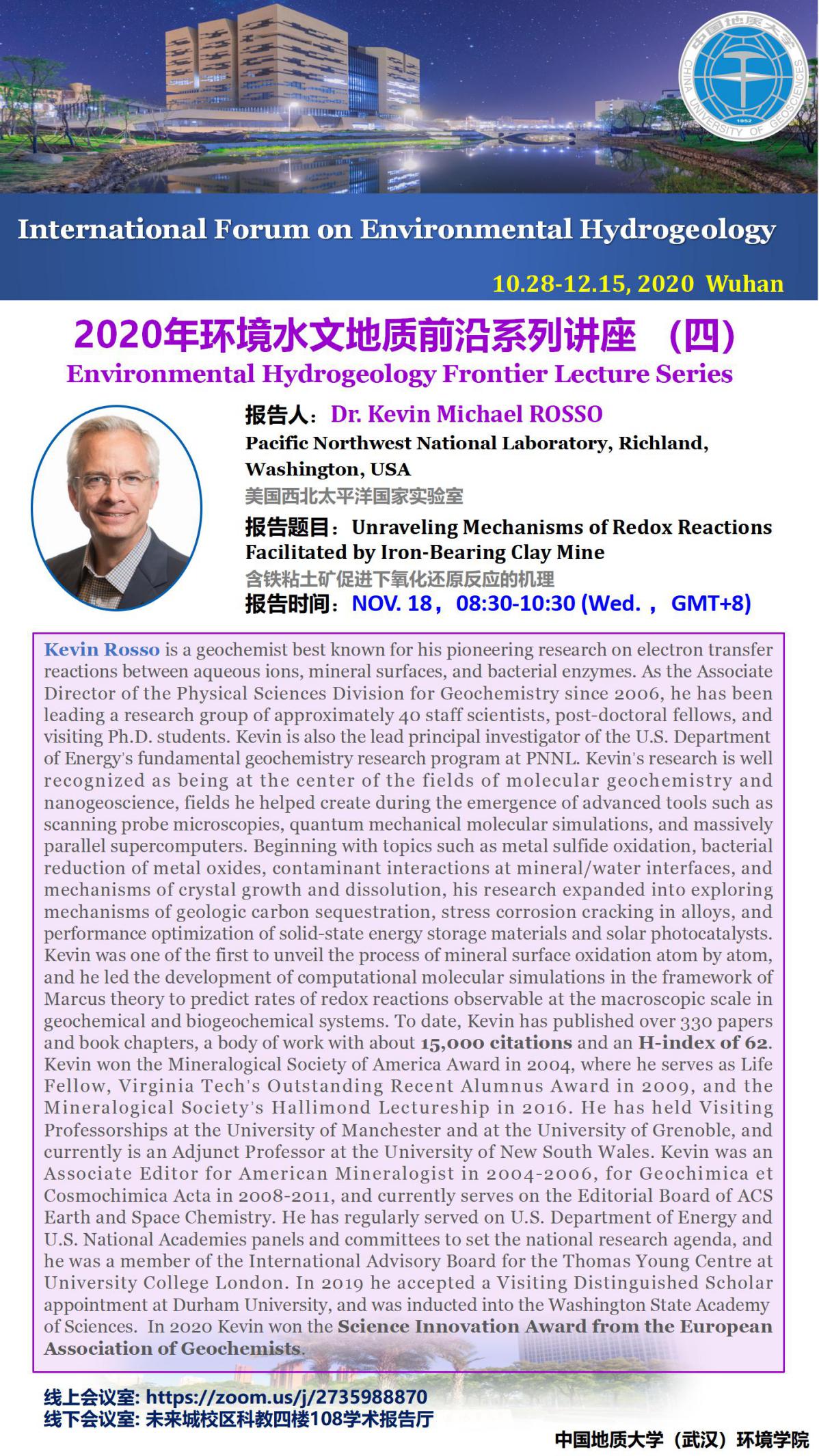Kevin Rosso博士,地球化学家,美国能源部西北太平洋国家实验室基础地球化学研究计划的首席研究员。他以对离子、矿物质表面和细菌酶之间电子转移反应的开拓性研究而闻名。已发表了330多篇论文和书籍章节,引用量约为15,000,H指数为62。
2004年,Rosso博士荣获美国矿物学学会奖,并担任弗吉尼亚理工大学终身研究员,于2009年获得该校杰出校友奖,并于2016年担任矿物学学会的哈利蒙德讲师。他曾担任曼彻斯特大学和格勒诺布尔大学客座教授,目前任新南威尔士大学的兼职教授。Rosso博士于2004-2006年担任《American Mineralogis》副主编,于2008-2011年担任《Geochimica et Cosmochimica Acta》副主编,目前担任《ACS Earth and Space Chemistry》编委。他常协助美国能源部和美国国家科学院制定各大研究议题,并且是伦敦大学学院托马斯·杨中心国际咨询委员会的成员。2019年,他荣获达勒姆大学访问学者奖学金,并入选华盛顿州科学院成员。2020年,Rosso博士获得了欧洲地球化学家协会颁发的科学创新奖。

演讲题目:Unraveling Mechanisms of Redox Reactions Facilitated by Iron-Bearing Clay Mine
摘要:
The Fe(II)/Fe(III) redox couple plays a commanding role in geochemistry, biology, and environmental science. Under reducing conditions, aqueous-soluble Fe(II) is an important source of electrons that control the valence and speciation of other metals, the transformation of organics, the production of radical oxygen species (ROS), and the metabolism of iron oxidizing bacteria. Under oxic conditions, sparingly soluble Fe(III) minerals are important metals sorbents, catalytic substrates, and electron acceptors for dissimilatory iron reducing bacteria. Any biogeochemical or hydrological process that causes movement of a redox boundary is thus likely to profoundly affect the system chemistry and microbiology by driving changes in the concentration balance between Fe(II) and Fe(III).
Iron-bearing clay minerals are important buffers for this concentration balance, through their unique ability to reversibly accept and release electron density by manipulation of structural Fe valance without decomposition of the enclosing silicate framework. However, relating structural iron content to redox buffering capacity and its associated redox reactivity remains poorly predictable, due in part to key fundamental knowledge gaps in 1) electron transfer mobility within iron-rich components of clay structures, 2) edge versus basal surface access to these electrons for interfacial redox reactions, and 3) the role and impact of adsorbed Fe(II).
This presentation will overview more than a decade of research into these fundamental questions, drawing heavily upon computational molecular simulations, synchrotron X-ray absorption spectroscopies, and temperature-dependent Mössbauer spectroscopy of redox reactions within and at surfaces of iron-bearing clay mineral structures. In particular, this has required a marriage of modern ab initio simulations and the electron transfer theory pioneered by Marcus more than half a century ago to predict electron hopping mobilities at room temperature in clays. Modeling and measurements of interfacial electron transfer kinetics to/from adsorbed Fe at edges and basal surfaces will be presented, and key remaining questions will be discussed. In addition to its basic importance to geochemical and biogeochemical redox processes in natural systems, these advances may also aid understanding of the antibacterial properties of clays because of their direct connection to heterogeneous Fenton reactions that sustain ROS generation at the clay/environment interface.
